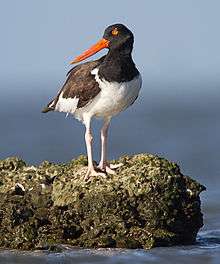American oystercatcher
| American oystercatcher | |
|---|---|
.jpg) | |
| On the Atlantic coast, New Jersey, USA | |
| Scientific classification | |
| Kingdom: | Animalia |
| Phylum: | Chordata |
| Class: | Aves |
| Order: | Charadriiformes |
| Family: | Haematopodidae |
| Genus: | Haematopus |
| Species: | H. palliatus |
| Binomial name | |
| Haematopus palliatus Temminck, 1820 | |
The American oystercatcher (Haematopus palliatus), occasionally called the American pied oystercatcher, is a member of family Haematopodidae. The bird is marked by its black and white body and a long, thick orange beak.
Description
The American oystercatcher has distinctive black and white plumage and a long, bright orange beak. The head and breast are black and the back, wings and tail greyish-black. The underparts are white, as are feathers on the inner part of the wing which become visible during flight. The irises are yellow and the eyes have orange orbital rings. The legs are pink. Adults are between 42–52 cm (17–20 in) in length.[2]
Distribution and habitat

The American oystercatcher is found on the Atlantic coast of North America from New England to northern Florida, where it is also found on the Gulf coast, and south to Brazil, Uruguay and Argentina. It is found also in the Pacific coast of California, Mexico, Central America, Peru, and Chile.[3] In the 19th century they became locally extinct in the northeast of the United States due to market hunting and egg collecting. After receiving protection under the Migratory Bird Treaty Act, their range extended northward to re-occupy historical habitat in New England.
Behavior
Oystercatchers are closely tied to coastal habitats. They nest on beaches on coastal islands and feed on marine invertebrates. The large, heavy beak is used to pry open bivalve mollusks. Oystercatchers raise a clutch of two or three eggs. In winter, they are found in flocks along the coast from central New Jersey to the Gulf of Mexico.[4]
Status
The IUCN lists this species as being of "Least Concern". The reasons given are that the bird has a very wide range and that the total number of individuals is believed to be stable, and actually increasing in the case of the United States.[1] Nevertheless, in some states American oystercatchers are listed as a species of concern because of low and declining populations. The threats to their coastal habitats includes development and recreational use of nesting beaches. This species is not protected under the Endangered Species Act.
Gallery
_in_flight.jpg) In flight in western Florida
In flight in western Florida- Nesting on Santiago Island, Galápagos Islands
 Two standing near their eggs in a nest on the Atlantic coast, New Jersey, USA
Two standing near their eggs in a nest on the Atlantic coast, New Jersey, USA
References
- 1 2 BirdLife International (2012). "Haematopus palliatus". IUCN Red List of Threatened Species. Version 2013.2. International Union for Conservation of Nature. Retrieved 26 November 2013.
- ↑ "American oystercatcher Haematopus palliatus". USGS. Retrieved 2013-12-12.
- ↑ "Species factsheet: Haematopus palliatus". BirdLife International. Retrieved 2013-12-12.
- ↑ "American Oystercatcher". Audubon. Archived from the original on 2013-11-26. Retrieved 2013-12-12.
External links
| Wikimedia Commons has media related to Haematopus palliatus. |
- American Oystercatcher videos, photos & sounds on the Internet Bird Collection
- American Oystercatcher Bird Sound
